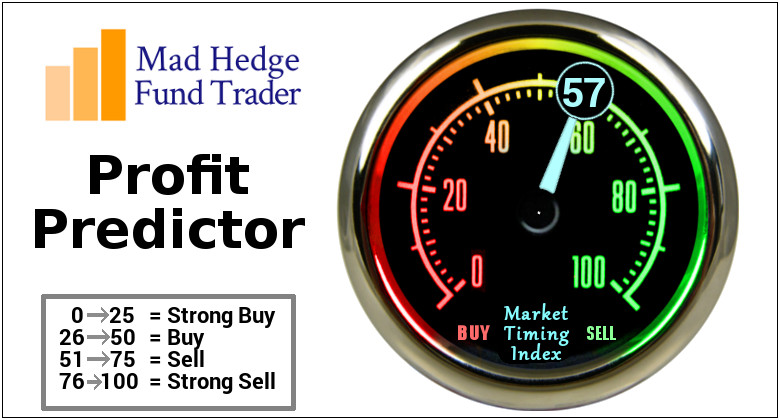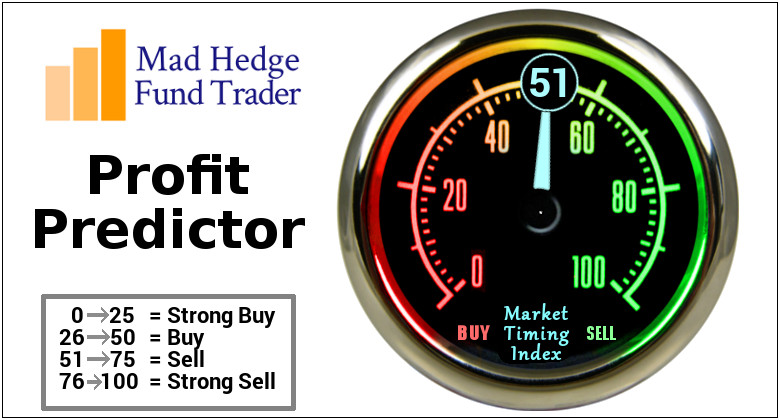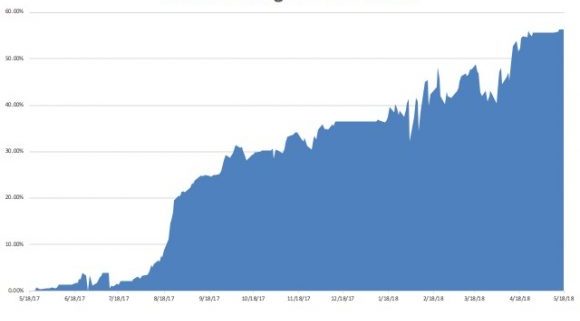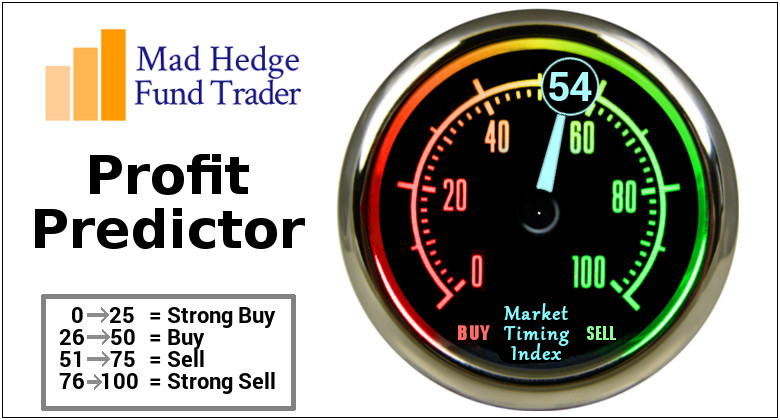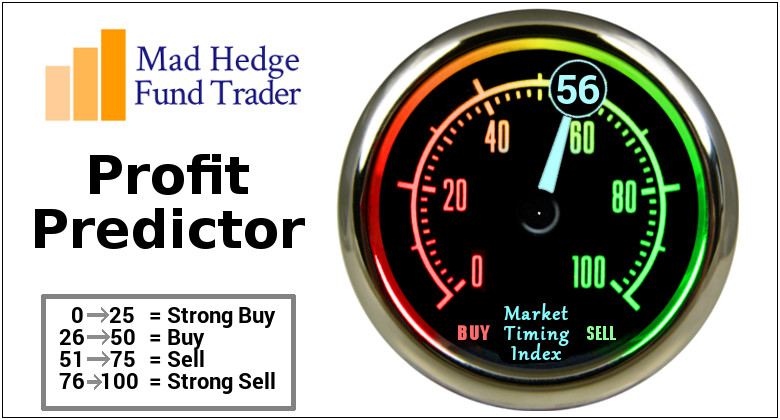Global Market Comments
May 22, 2018
Fiat Lux
Featured Trade:
(DON'T MISS THE MAY 23 GLOBAL STRATEGY WEBINAR),
(CHINA'S BIG TRADE WIN),
(SPY), (TLT), (UUP), (USO), (GLD), (SOYB),
(HOW TO USE YOUR CELL PHONE ABROAD)
My next global strategy webinar will be held live from Silicon Valley on Wednesday, May 23, at 12:00 PM EST.
Co-hosting the show will be Mad Day Trader Bill Davis.
I'll be giving you my updated outlook on stocks, bonds, commodities, currencies, precious metals, and real estate.
The goal is to find the cheapest assets in the world to buy, the most expensive to sell short, and the appropriate securities with which to take these positions.
I will also be opining on recent political events around the world and the investment implications therein.
I usually include some charts to highlight the most interesting new developments in the capital markets. There will be a live chat window with which you can pose your own questions.
The webinar will last 45 minutes to an hour. International readers who are unable to participate in the webinar live will find it posted on my website within a few hours.
I look forward to hearing from you.
To log into the webinar, please click on the link we emailed you entitled, "Next Bi-Weekly Webinar - May 23, 2018" or click here.
My phone started ringing on Sunday afternoon as soon as the futures markets opened in Asia. The U.S. had reached agreement with China on trade and the Dow futures were up 200 points.
Had the next leg of the bull market begun? ?Was it time to buy?
I asked what were the specifics of the deal. There weren't any. I asked about generalities. Those were absent as well.
All they knew was that the U.S. was suspending threatened tariff increases in exchange for a vague Chinese promise to buy more U.S. exports over the long term.
It was in effect a big Chinese win. The development allows the Middle Kingdom to do nothing but stall for time until the next U.S. administration comes to power regardless of which party wins. The Chinese think in terms of centuries, so waiting three more years for a better negotiating backdrop is no big deal.
It vindicates my own call on how the Chinese trade war would play out. After a lot of threats and saber rattling, the administration would achieve nothing, declare victory, and go home.
Traders should NOT be buying this pop in stock prices on pain of death. All that will happen is that stocks will trade back up to the top of the recent range, and then stall out once again as we slide back into slow summer trading. In fact, all we have accomplished is to revisit last week's high in stocks.
Stocks (SPY) weren't buying this trade agreement for two seconds, nor were bonds (TLT), foreign exchange (UUP), gold (GLD), or energy (USO). Not even the agricultural markets were believing it. Soybeans (SOYB), the commodity most affected by the China trade, were up a measly 2.45%. If markets really believed something substantial was afoot they would be limit up three days in a row. I've seen this happen.
It was obvious that little was accomplished when you saw the endless parade of administration officials praising the deals merits. My half century of trading experience has taught me when someone is working so hard to sell you a bridge, you look the other way.
And here is the problem. Beyond cutting-edge technology, there's nothing that China HAS to buy from the U.S. China's largest imports are in energy and foodstuffs, both globally traded commodities.
The oil and gas coming out of America looks pretty much like the Saudi Arabian and Russian kind. U.S. energy infrastructure is already groaning at the seams as it approaches 11 million barrels a day.
To double that from current levels just to fill the trade gap with China would require a multi-decade effort financed with trillions of dollars in private capital just to produce more oil with prices at a three-year high. In other words, it isn't going to happen.
The same is true with agriculture. I doubt there is a single farmer in the country willing to risk his own money to increase production on the back of the China deal. Rainfall is a much bigger concern.
In the end, stocks will eventually rise to new highs by the end of the year, just not right now. And they will do so on the back of the prodigious earnings growth of U.S. companies, which has been expanding at a breakneck pace for nearly a decade.
It is notable that the only major index that hit new highs today was the small cap Russell 2000 (IWM) where the constituent companies essentially do NO trade with China.
To believe otherwise would be giving the cock the credit for the sun rising, which happens every morning like clockwork.
It Worked Again!
I constantly receive emails from readers around the world inquiring how I accomplish this or that in my far-reaching travels around the globe.
After all, I have visited 125 countries over the past 50 years. What's more, I have run the Mad Hedge Fund Trader Global Empire for the past 10 years, on the fly, from a laptop and a cell phone.
Given that Europe is now 20% cheaper than last year, and 40% less expensive than four years ago, an increasing number of you are going to cross the pond for your summer vacation.
That certainly was the case this year, when I saw a substantially larger number of American families traveling with children.
For the first time in decades, I am finding gaggles of American students in train stations backpacking their way around the continent with a Eurail Pass, much like I did in the 1960s.
With the right information, your cell phone can make your trip vastly more enjoyable, while preventing it from becoming wildly expensive. In fact, it is hard to imagine how we got along without them. So here goes:
1) Hardware
U.S. issued phones only work abroad if you have an international SIM card, as do most iPhones. Before you leave, call your cell phone provider and ask if you have an international SIM card in your phone.
Each company has exactly one person who knows how this works. If you don't have one, get one. The person at Verizon is named Maria.
Upon arriving abroad, the truly adventurous remove their American SIM cards and install a local one, signing up for a local plan. This can cut your international bill to as little as $10 a month.
You just reinstall your U.S. SIM card when you return home. However, as SIM cards are too small for me to see, I have yet to attempt this bit of technological acrobatics.
If you keep your U.S. SIM card, to make a call when abroad you have to assume you are still in the United States, since you have a U.S. number.
To call another country in Europe just hold down the "0" in your phone number pad until a + sign appears. Then dial 011 for the international exchange, and the numbers for the local country and city codes.
To call the U.S. from abroad, hold the "0" until a + sign appears, then dial 1, then the area code and number.
2) Roaming
International roaming can cost a fortune. Before I figured out the game, I was spending $500 a week downloading email, newspapers, and research reports. TED talks are the worst, costing at least $25 each to watch over foreign air.
So it is crucial to turn off the roaming feature on your phone. On an iPhone you do this by going into settings, then cellular data, and then turning the cellular data function off. Do this, and you will still be able to receive voice calls, such as from a lost traveling companion in distress.
Here is the key rule: Only access the Internet through the free Wi-Fi at your hotel. Download all your big files, news, email here. This saves you a ton of money.
You will need to turn on you cellular roaming to get your apps to work. But if you have already downloaded the big files, the additional cost to check your stock prices, weather forecast, or the way to a sought-after restaurant will be minimal.
Another tactic is to de spam your email accounts. Find all of those useless, unsolicited marketing emails promising get rich quick schemes, dating opportunities, or male enhancements. Then mark them as spam (unless they are from me). When you do use your cellular roaming, they won't eat up all of your data budget.
Warning: Start doing this every day a month before you leave. That's how much spam is out there. You can always unmark email as spam from senders you like, such as the local public library, when you return home.
American companies finally now offer international plans. This year Verizon is offering 250 MB of data, 250 emails and text messages, and 250 minutes of talk time for $80 a month. This is nowhere near enough, but it is a start.
Every time you cross a border, the local cell phone company will text you with usage and overage rates, which is usually $25 per 100 MB of data, or 10 cents a minute for voice or messaging.
You can find the Americans on a train when their phones all ping at once, often when you cross a bridge, or come out of a tunnel, or land at an airport.
3) Apps
Google Maps can provide perfect, detailed directions on how to reach the most remote destinations, whether you are in the Istanbul Bazaar, the Marrakech Medina, or the back alleys of Rome.
You can choose instructions whether you are on foot or driving. As soon as you arrive at your hotel, type in the address so you can always find home. The really great thing about Google Maps is that, unlike paper maps, it tells you where you are.
Just be careful not to bump into another traveler who is similarly staring at his cell phone to find his way (I walked straight into a concrete lamppost once in Tokyo and almost knocked myself out).
Be sure to download a free flashlight app before you leave home. These are great for navigating your way down dark streets, reading a menu in an ill lit restaurant, or finding the keyhole in your door.
The weather app is indispensable. It will allow you to fine-tune your travel plans up to a week in advance.
Being an ex-Boy Scout, I find a compass app particularly useful. Knowing where magnetic north is comes in handy when using those free tourist maps.
Stock market apps will bring you the assurance that the Mad Hedge Fund Trader Alerts are working well and paying for the entire trip. Remember that the New York Stock Exchange opens at 3:30 PM on the European continent because of the time change.
Travel in Europe is made much easier when you speak seven languages, although it's hard to find a living Roman centurion to practice your Latin. Limited to the King's English?
No problem! Get free language apps for the countries of your destination. Sometimes, the translation of a single word can mean the difference between life and death.
It's better to pay a couple of bucks and get the expanded vocabulary apps so you never come up short. That is how I found out yesterday that "sardi" is a type of Italian pasta unique to Northern Italy, and not a sardine.
You may have your own special apps you use. I like to visit my Tesla occasionally, verifying that it is still in my garage and fully charged. I also like to check the daily output of my solar panels to prove that my house is still standing.
Coming from California, I can never be sure. Google Earth is useless here because the pictures can be up to six months old. They are obviously lacking on satellite time.
4) Security
Identity theft is exploding in Europe, thanks to the close proximity of a hacker's paradise in unpoliced Eastern Europe. Never access your financial accounts through a free public network that is not password protected. It's like leaving your wallet in the middle of Saint Mark's Square in Venice and expecting to find it there an hour later.
Don't even attempt an innocent checking of balances. And I don't mean a password like 123456789. You can count on your accounts getting cleaned out. There is no greater bummer than being told by a hotel clerk that you can't check out because all of your credit cards have been canceled.
If you do need to check your balance on the run, do it only through your cell phone, and only over a cell network (no Wi-Fi), where an extra level of security is provided. The same is true with inter-account transfers. This can be expensive, but it is worth it.
Please note, that in China, the security situation is becoming so severe that many multinationals will not permit employees to bring their laptops. They have adopted "cell phone only" policies in the Middle Kingdom, where the security is so much better.
Too many western visitors were getting their entire hard drives copied by these crooks searching for western intellectual property, in addition to the easy pickings among bank accounts.
5) Entertainment
OK, so watching Wheel of Fortune in German, French, or Italian is not your cup of tea. Before you leave home and still have reasonable broadband, download a batch of old movies from iTunes, Netflix, or Amazon to your laptop.
That way, you have something to do in the middle of the night waiting for your jet lag to adjust. Bring a 6-foot HDMI cable and you can change the input channel on your hotel TV, plug in, and watch your flick there.
6) Bandwidth
European bandwidth can vary all over the map, from lightning fast (the Ritz Carlton in Barcelona) to painfully slow (Agadir, Morocco). Europeans just don't seem to grasp how fast apps are growing, and bandwidth demand is accelerating.
More than a few times, I have had to crawl under front desks and reboot routers to get systems working again.
Suffice it to say, the more you pay, the faster your Wi-Fi. If you check into your hotel and see half the residents sitting in the lobby checking their email, it is not a good sign.
Wi-Fi was invented in the U.S., where 2-by-4 wooden studs and 1-inch sheetrock used in construction is common.
Two-foot thick stonewalls typical in historic European city centers (where you will want to stay) are terrible for Wi-Fi range, and it is not unusual to have no access from your room.
If Apple or Microsoft want to upgrade your operating system on the road, wait until you get home. Otherwise, you might crash your system and not be able to use your device until you return home.
7) Tickets
It is now possible to do a search of your next foreign city for coming events while you are on a train, buy tickets online, and show the ticket on your phone to gain admission.
I also have settled a couple of checkout disputes proving that I prepaid hotel stays by displaying proof of payment from my PayPal or bank account.
Incredible, but true.
I will be following this piece up with another on general travel tips in a couple of weeks entitled Travel Tips from a Pro, which I am now working on.
In the meantime, enjoy your trip.
"Who knew the blockbuster this year would be a horror show," said Tony Crescenzi, market strategist and portfolio manager at bond giant, PIMCO.
Global Market Comments
May 21, 2018
Fiat Lux
Featured Trade:
(JOIN ME ON THE QUEEN MARY 2 FOR THE MAD HEDGE JULY 11, 2018 SEMINAR AT SEA),
(THE MARKET OUTLOOK FOR THE WEEK AHEAD, or NO TRADE),
($INDU), (SPY), (TLT), ($TNX), (CPB)
Come join me in the grand appointments of the Cunard Line's flagship, the elegant and spacious Queen Mary 2, on an eastbound transatlantic cruise.
The ship departs New York at 10:00 AM on July 6, 2018 and arrives at Southampton on July 13. There I will be conducting the Mad Hedge Fund Trader's Strategy Update, a three-hour discussion on the global financial markets.
I'll be giving you my up-to-date view on stocks, bonds, currencies, commodities, precious metals, energy, and real estate. I'll highlight the best long and short opportunities.
And to keep you in suspense, I'll be tossing a few surprises out there, too. Enough charts, tables, graphs, and statistics will be thrown at you to keep your ears ringing for a week. Tickets are available for $300 for the seminar only.
Attendees will be responsible for booking their own cabin through Cunard. They offer everything from an inside stateroom from $999 per person to $26,780 for a Q1 deluxe two-bedroom apartment with its own gym.
Just visit the Cunard website or call them directly at 800-728-6273 to make your own arrangements.
The weather this time of year can range from balmy to tempestuous, depending on our luck. A brisk walk three times around the boat deck adds up to a mile. Full Internet access will be available, for a price, to follow the markets.
Every dinner during the voyage will be black tie, so you might want to stop at Saks Fifth Avenue in Manhattan to get fitted for a second and third tux. Don't forget to bring your Dramamine and sea legs, although the 151,400 ton, 1,132-foot-long $900 million ship is so big I doubt you'll need them. The Queen Mary 2 just completed a major refit in Germany, so everything is brand new.
The event will be held at a luxurious penthouse suite on the ship's highest deck, the details of which will be emailed to you with your purchase confirmation. To instill us all with a proper sense of humility, I will conduct the seminar as we sail over the wreck of the Titanic. The ship will give a blast of its horn three times as a salute as we pass the site.
I look forward to meeting you and thank you for supporting my research.
To purchase tickets for the seminar alone, CLICK HERE.
That was the most boring week of 2018.
Not only did we get no net movement; the range was an infinitesimal 200 Dow points. It was hardly enough to make a dog's breakfast.
Of course, the big news was the yield on the 10-year U.S. Treasury bond (TLT), which rose to 3.12%, a seven-year high. You might have expected this to prompt a complete stock market rout. It didn't. Maybe that is next week's business.
It is rare that the bullish and bearish arguments reach a perfect balance, but that is what we got. In the meantime, trading volume is shrinking, never a good sign. Will the last one to leave please shut out the lights?
Which is all an indication of what I have been warning you about for months. This is setting up to be a dreadful summer. If you've already made your year, with a 19.88% gain like I have, you're better off taking a long cruise than trying to outsmart the algorithms.
I managed to squeeze off only one trade so far this month. I sold short the S&P 500 (SPY) right at the high of the week. However, when the downside momentum failed, and a Volatility Index (VIX) spike failed to confirm, I bailed for a small profit. Pickings are indeed thin.
Whenever my trading slows down, I get the inevitable customer complaints. My answer is always the same. Reach for the marginal trade and you will get your fingers bit off. Don't be in such a hurry to lose money. As my wise Latin professor used to say, "Festina lente," or "make haste slowly."
My May return is +0.53%, my year-to-date return stands at a robust 19.83%, my trailing one-year return has risen to 56.25%, and my eight-year profit sits at a 296.30% apex.
And remember, the market is making this move in the face of rising oil prices and interest rates, always bull market killers.
To mix a few metaphors, when the sun, moon, and stars line up once again I'll go pedal to the metal with the Trade Alerts once again.
If you held a gun to my head and ordered me to tell you how the markets will play out for the rest of the year, try this.
We remain is this narrowing trading range for months, ending with a final decisive break of the 200-day moving average to the downside, now at 23,909. But we find a new low only 1,000 points, or 4% below that.
Then we launch into the post midterm election year-end rally, which could take stocks up 15% to 20% from the 23,000 low. This is why I have been saying that the best trades of 2018 are ahead of us.
So, renew that subscription!
To witness how cruel and stock specific the current market is, look no further than hapless Campbell Soup (CPB), the first ticker symbol I have had to look up this year. There is probably not a reader alive who was not nursed back to health by its iconic red canned chicken noodle soup.
A surprise earnings loss triggered a hellacious 14% one-day plunge. It is the first big victim of the new steel tariffs. Although it amounts to only a few pennies a can, that can be disastrous in this hyper-competitive world. It also turns out that Millennials prefer eating fresh food rather that the canned stuff.
Give thanks for small mercies. With three daughters I am at ultimate risk for a tab for three weddings. The nuptials for Meghan Markle and Prince Harry are thought to cost $45 million, most of it on security. Hopefully I will not someday become the father-in-law of a prince.
This coming week has a plethora of Fed speakers, some key housing numbers, and that's about it.
On Monday, May 21, at 8:30 AM, we get April Chicago Fed National Activity Index.
On Tuesday, May 22, nothing of note is announced.
On Wednesday, May 23, at 10:00 AM, the April New Home Sales.
Thursday, May 24, leads with the Weekly Jobless Claims at 8:30 AM EST, which saw a rise of 11,000 last week from a 43-year low. At 10:00 AM, we get April Existing Home Sales.
On Friday, May 25, at 8:30 AM EST, we get April Durable Goods Orders.
We wrap up with the Baker Hughes Rig Count at 1:00 PM EST.
As for me, I will be spending the weekend putting the finishing touches on my 2018 Mad Hedge European Tour.
Thanks to rising U.S. interest rates and a strong dollar, the price of a continental trip has dropped about 10% since the beginning of the year. Got to love that Swiss franc at 1:1 parity with the greenback. Maybe I can afford an extra cheese fondue.
Good Luck and Good Trading.
Yes, It All Looks Like Magic
Global Market Comments
May 18, 2018
Fiat Lux
Featured Trade:
(THEY'RE NOT MAKING AMERICANS ANYMORE),
(THE DEATH OF THE FINANCIAL ADVISOR)
Global Market Comments
May 17, 2018
Fiat Lux
Featured Trade:
(WHY THE "MIDTERM EFFECT" RULES THE MARKETS),
(WHO SAYS THERE AREN'T ANY GOOD JOBS?),
(TESTIMONIAL)
Legal Disclaimer
There is a very high degree of risk involved in trading. Past results are not indicative of future returns. MadHedgeFundTrader.com and all individuals affiliated with this site assume no responsibilities for your trading and investment results. The indicators, strategies, columns, articles and all other features are for educational purposes only and should not be construed as investment advice. Information for futures trading observations are obtained from sources believed to be reliable, but we do not warrant its completeness or accuracy, or warrant any results from the use of the information. Your use of the trading observations is entirely at your own risk and it is your sole responsibility to evaluate the accuracy, completeness and usefulness of the information. You must assess the risk of any trade with your broker and make your own independent decisions regarding any securities mentioned herein. Affiliates of MadHedgeFundTrader.com may have a position or effect transactions in the securities described herein (or options thereon) and/or otherwise employ trading strategies that may be consistent or inconsistent with the provided strategies.

